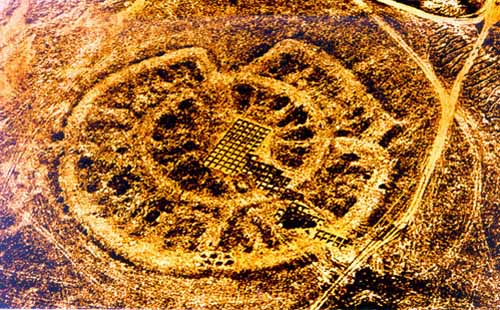

Arkaim is an archaeological site situated in the Southern Urals steppe, 8.2 kilometres (5.1 mi) north-to-northwest of Amurskiy, and 2.3 km (1.4 mi) south-to-southeast of Alexandronvskiy, two villages in the Chelyabinsk Oblast, Russia, just to the north from the Kazakhstani border.
The ancient Ural fortress is called Russian Stonehenge. In addition to streets and buildings ruins scientists found remnants of the water system, metallurgic furnaces, and mines. It is also believed to be one of the strongest anomaly zones in Russia.
The site is generally dated to the 17th century BC. Earlier dates, up to the 20th century BC, have been proposed. It was a settlement of the Sintashta-Petrovka culture. Newly found artifacts make the site itself much older; scientists agree on it being at least as old as Troy and the Egyptian pyramids; it dates back to the 4th millennium BC. It is said to be older then Stonehenge (3300 BC).
The site was discovered in 1987 by a team of Chelyabinsk scientists who were preparing the area to be flooded in order to create a reservoir, and examined in rescue excavations led by Gennadii Zdanovich. At first their findings were ignored by Soviet authorities, who planned to flood the site as they had flooded Sarkel earlier, but the attention attracted by news of the discovery forced the Soviet government to revoke its plans for flooding the area. It was designated a cultural reservation in 1991, and in May 2005 the site was visited by then-President Vladimir Putin.
During the excavations of Arkaim no jewellery was found, no masterpieces of ancient art, no unknown writings, nor other such treasures - only fragments of broken ceramic ware, bones of domestic and wild animals, an occasional stone tool and even more rare, bronze tools. But even those common things are not well presented at Arkaim. The collection of artifacts is so poor and unimpressive, that it is not possible to make a museum exhibit appropriate to the site. Therefore, from the point of view of archeologists, the main value of the ruins was, and probably will be, the design of the structures itself and their lay-out.
The structures were tall; they had solid walls, gallery ceilings, wood-paved roadways, second floors and high wooden towers. Nowadays, archeologists have a more complete picture of how the settlement in the Arkaim Valley looked at the time of its peak, and it is quite impressive. First of all it is important to emphasize the point that this large settlement was not a collection of separate structures, but an all-inclusive design and construction. The total area extends to about twenty thousand square meters (twenty-four thousand square yards), and the settlement ground-plan is comprised of two circles, one inside the other, made of massive defensive walls.
The external wall is about 160 meters (500 feet) in diameter. It was surrounded by a ditch 2 meters (6.5 feet) wide, filled with water. The external wall is very massive, 5.5 meters (16 feet) high and five meters wide. It was constructed of timbered cages filled with soil and added lime, and an outer facing of cob blocks. Four entries were designated in the wall: the largest-one southwesterly and three smaller ones located on opposite sides.
Inside the city entrance is the only ring-shaped street, about 5 meters (18 feet) wide, that separates dwellings adjoining the external wall from the internal ring-shaped wall. As mentioned above, the street had timbered flooring under which, along its full length, the 2 meter-wide (6 feet) ditch was dug which connected to the external ditch. Thus, the city had their storm water drain, the overflow of water filtered through the timbered roadway into the ditch which then went into the external ditch.
The circles of the dwellings were divided into sectors by radial walls, spaced in between every two premises. In the plan they look similar to wheel spokes. There were thirty-five dwellings at the external wall and twenty-five dwellings at the internal one.
One end of every dwelling adjoined either the external or the internal wall, and faced either the main ring-shaped street or the central square. In an improvised hall there was a special water drain which went into the ditch under the main street. Yes, as we saw earlier, ancient Aryans had a water drain! Furthermore, each dwelling enjoyed a well, a furnace and a small dome-shaped storage place.
From the well, above the water level, two earthen pipes branched off. One of them went to the furnace, another one to the dome-shaped storage place. What for? The most ingenious things are often simple. We all know that if one looks into a well one feels a flow of cool air. And so in the Aryan furnace, this cool air, passing through the earthen pipe, created a draught of such power, that they could mould bronze without use of bellows. It appears that each dwelling had such a furnace and ancient metal smiths only needed to perfect their skills to compete in this art. Another earthen pipe provided air to the storage place, of a lower temperature than the ambient air: some type of a refrigerator?
The central square that crowns Arkaim is approximately 25 by 27 meters (82 by 88 feet). Judging by the remnants of the fire places which were situated in specific locations, this was the square to fulfill certain sacraments.
The complicated and well planned internal lay-out of dwellings and ring-shaped streets made a sophisticated trap for uninvited visitors, in the divide between the external defensive wall and other fortifications as well as an efficient storm water drainage system. Even the colors of the "facing materials" used by ancient Arkaim inhabitants were functionally and aesthetically significant.
Further on, we see the ring of the internal wall with a puzzling purpose. It is even more massive than the external wall, being 3 meters wide (9 feet) by 7 meters high (22 feet). This wall, according to excavation data, has no entry, except for a small doorway in the southeast which isolates the twenty-five internal premises from all the rest. To approach the small entry in the internal ring, one had to go along the whole length of the ring-shaped street.
This not only served defensive purposes, but also had a sacred meaning. To enter the city, one had to follow the Sun. Most likely, people who lived within the internal ring possessed something that was not meant to be seen even by those living in the external ring, let alone external observers.
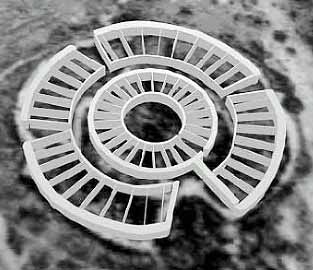
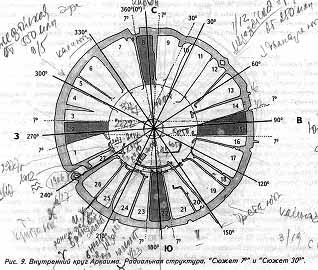
The obvious complexity of the social order of a people who built such a structural and artistic miracle several millennia ago is not all that an expert’s eye would notice in observing the contours of this ancient proto-city. The geometry of the construction conceals in itself some riddles: Why is it a circle? Was it linked to symbolism relevant to the spiritual philosophy of the ancients? If yes, then what do these symbols express and to whom? What kind of message are they meant to relay? Following are some suggestions made by the first researchers of Arkaim, G.B. Zdanovich and I.M. Batanina.
They realized that its lay-out, the ground-plan of Arkaim, is related to the Mandala principle, a square inside a circle - one of the basic sacred symbols of Buddhist philosophy.
The word Mandala is translated as a circle or disk. In the ancient Rig-Veda writings, where it has been first described, the word has a set of values: a wheel, a ring, the country, space, society, gathering.
The symbolic meaning of a Mandala is understood all over the world as a model of the Universe, even of the entire cosmos, where the two most important principles present in our Universe are represented in the form of a circle and a square. Arkaim, with its dwellings, having adjoining rooms, might possibly represent the "wheel of time", where every aspect is defined by the previous one and in turn, defines the next one.
Did these ancient sages, perfectly familiar with the structure of the Universe, see how harmoniously and naturally it is arranged and therefore, constructed their city as a mini-Universe? And the engineering genius of these ancient builders, which we already explored, is equally admirable.
And now, further into these explorations, come more far-reaching conclusions which can be taken as a key to the most important riddle of Arkaim: In the 'Land of Cities', its most amazing distinction is not any richness of artifacts, but its surprisingly high level of spiritual culture. It represents a special world that in many aspects is permeated with spirituality, from settlement and funeral architectural forms to sculptured images chiseled into stone.
Arkaim’s constructions are both complicated and sophisticated, but their true purpose and functions are not very obvious. And only when its accurate geometry is discovered in the lay-out is it possible to comprehend the builders' messages. By way of various essential elements of geometry and the dimensions of Arkaim, researchers are directed to precise correspondences with certain parameters of Great Britain's ancient Stonehenge.
In all archaeological publications about Arkaim the diameter of the ring-shaped wall of the citadel is listed as eighty-five meters. In fact, this figure is slighty rounded-off. If it is measured with the accuracy needed for astronomical purposes it turns out for the imperfectly shaped ring to be having radiuses of 40 and 43.2 meters. The radius of the “Obri holes” ring in Stonehenge is also 43.2 meters. Both ancient sites are located basically at the same latitude; both are in the middle of bowl-shaped valleys with hilly horizon views. And this is not all: The more accurately both sites are compared, the more details are found which are precisely concurring.
At Arkaim and associated ancient sites, the radiocarbon analysis was done not less than three times, using tens of probes. It turns out that in most cases Arkaim is of the same age as Stonehenge or even older.
The resemblance of these two ancient sites and their ages have much significance, particularly the implication that household articles of a civilized world migrated not from cultural Greece to wild Siberia, but very much the other way around. It also means that regarding the designs of both sites, one should search for one common denominator rather than dismiss the similarities, believing them to be mere coincidences.
There is of course, one complication: The stone monoliths of Stonehenge have passed through millennia practically damage-free, whereas the wooden elements of design of the Southern Ural proto-city are almost completely lost. They did not decay but were destroyed in a fire raging here almost five thousand years ago.
The fire that eliminated the 'living' history of Arkaim is among the most intriguing riddles of this ancient structure. It would be less strange if it was one of those natural disasters that even today, quite often, suddenly destroy whole settlements, taking inhabitants off-guard and burying belongings, along with anyone who couldn’t escape.
The singularity of Arkaim’s fire is that it was, apparently, not unexpected for inhabitants and it is quite possible that the inhabitants caused it themselves. Only this could explain the fact that in the ancient ashes there are no intact household items, only fragments and splinters and there are no human remains at all. They all left alive, and carried away everything valuable. Why? We can only guess now. Nevertheless there is an immutable fact; being built at once, as a one-time project, the proto-city Arkaim also ceased to exist overnight, was left by all inhabitants and, possibly, burnt down by them.
Comparisons of Arkaim with Stonehenge are not accidental. Careful research of Arkaim by archeologists and astronomers has determined that it is a celestial observatory of ultimate accuracy. Modern astronomers have been surprised by the fact that a project of such versatility, complexity and accuracy has been fulfilled, the more that no traces of earlier and simpler constructions were found.
Notable in the collection of confirmed patterns is the use of the Golden Section rule in the internal circle, consisting of 27 walls and 12-sectioned zodiac partitionings.
The internal circle has been devoted to the Sun, the external one to the Moon. The inclination of lunar orbit to the ecliptic plane (5ľ 09 ') is defined very precisely.
In the erection of the ring-shaped internal wall they used a circle with a radius measuring 52.65 of Arkaim’s linear measures (one Arkaim linear measure equals 80.0 cm) that corresponds to 52° 39' the latitude of Arkaim. The latitude of Arkaim, by the way, is close to the latitude of Altai barrow Arjan (52° 00 ') and Stonehenge (51° 17'), and it is possible that this strip on the Earth’s surface, as well as the 30th parallel, had significant meaning for ancient astronomers and priests.
Measurements confirmed that the ancients of the Southern Ural were aware of the phenomenon of the precision of the Earth’s axis expressed in ratios of the internal circle. The period of this phenomenon is enormous - 25,786 years, but Arkaim’s builders portrayed corresponding parameters perfectly and very precisely. Researchers specifically note that in order to create this sort of observatory they had to know that the Earth has the form of a sphere and together with other planets spins around the Sun... (On Arkaim’s ceramic ware, the sacred sign for the “sun wheel”, a swastika was found.) Another surprise is that the city itself, and mortuary facilities in its plan, represent the combination of a circle and a square.
On our planet, quite a few archeological finds confound modern science: the Egyptian and Mayan pyramids, the great figures of the Nasca desert, Stonehenge in England, Zorats-Kar in Armenia and, it seems, our Arkaim.
It is hard to explain how our ancestors managed to build these amazing constructions, or for what purpose, but it is impossible to ignore them. American researcher Jerald Hockings asserts that to erect Stonehenge required no less than one and a half million man-days, a vast, simply Immeasurable expenditure of power. For what? And then there is Arkaim - for what? The largest, and according to K.K. Bystrushkin, the most perfect celestial observatory, constructed by people we assumed were “primitive” and half-civilized, living almost five thousand years ago in the Southern Ural steppes?
Here we are talking about complicated sites such as Stonehenge and Arkaim and yet, we do not even understand the much more simple and humble Dolmen structures. But even they certainly have astronomically significant orientations and they are, in fact, the most ancient calendars of mankind, not to mention their other important functions.
Maybe we have yet to make an objective assessment of mankind's distant past? With the chauvinistic attitude modern science brings to these discoveries, what if we have grossly misrepresented our ancestors' level of "primitiveness"?
Suppose that our ancestors were no more primitive than we are and just lived differently, according to principles and values unknown to us? What if K.K. Bystrushkin is correct in asserting that Arkaim is more sophisticated than we are, and if we wish to understand it we would have to grow up in order to match its heights?
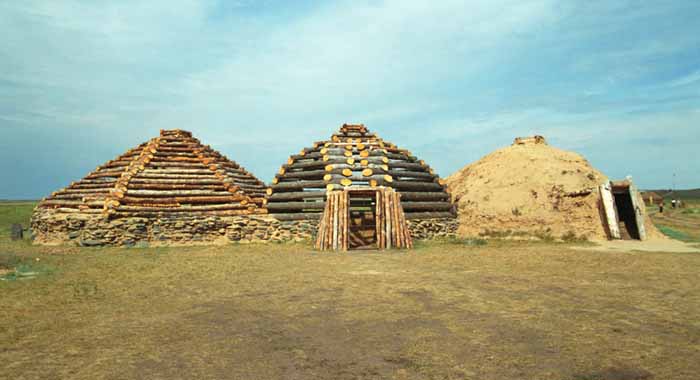
Although the settlement was burned and abandoned, much detail is preserved. Arkaim is similar in form but much better preserved than neighboring Sintashta, where the earliest chariot was unearthed. The site was protected by two circular walls. There was a central square, surrounded by two circles of dwellings separated by a street. The settlement covered ca. 20,000 m2 (220,000 sq ft). The diameter of the enclosing wall was 160 m (520 ft). It was built from earth packed into timber frames, and reinforced with unburned clay brick, with a thickness of 4–5 m (13–16 ft). and a height of 5.5 m (18 ft). The settlement was surrounded with a 2 m (6 ft 7 in)-deep moat.
There are four entrances into the settlement through the outer and inner wall with the main entrance to the west. The dwellings were between 110–180 m2 (1,200–1,900 sq ft) in area. The outer ring of dwellings number 39 or 40, with entrances to a circular street in the middle of the settlement. The inner ring of dwellings number 27, arranged along the inner wall, with doors to the central square of 25 by 27 m (82 by 89 ft). The central street was drained by a covered channel. Zdanovich estimates that approximately 1500 to 2500 people could have lived in the settlement.
Surrounding Arkaim's walls, were arable fields, 130–140 m by 45 m (430–460 ft by 150 ft), irrigated by a system of canals and ditches. Remains of millet and barley seeds were found.
The 17th century date suggests that the settlement was about co-eval to, or just post-dating, the Indo-Aryan migration into South Asia and Mesopotamia (the Gandhara grave culture appearing in the Northern Pakistan from ca. 1600 BC, the Indo-European Mitanni rulers reached Anatolia before 1500 BC, both roughly 3,000 kilometres (1,900 mi) removed from the Sintashta-Petrovka area), and that it was either an early Iranian culture, or an unknown branch of Indo-Iranian that did not survive into historical times.
Since its discovery, Arkaim has attracted public and media attention in Russia, from a broad range of the population, including esoteric, New Age and pseudoscientific organizations. It is said to be the most enigmatic archaeological site within the territory of Russia, and as with many archaeological discoveries, many conflicting interpretations have been put forward.
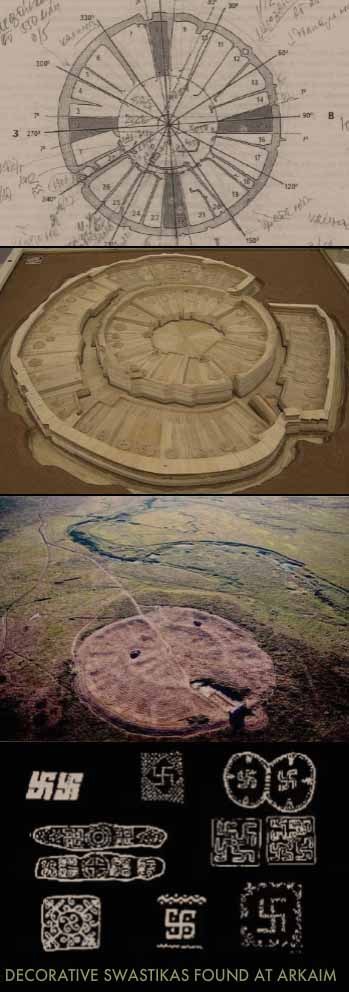
In order to gain publicity, the early investigators described Arkaim as "Swastika City", "Mandala City", and "the ancient capital of early Aryan civilization, as described in the Avesta and Vedas". The swastika description refers to the floor plan of the site, which (with some imagination) may appear similar to the swastika symbol, albeit with rounded arms (similar to the lauburu) attached to a central ring instead of a cross.
The similarity of latitude, date, and size led some archaeoastronomists (Bystrushkin 2003) to compare Arkaim with Stonehenge in England. According to their claims, the Neolithic observatory at Stonehenge allowed for observation of 15 astronomical phenomena using 22 elements, whereas the contemporaneous observatory at Arkaim allowed for observation of 18 astronomical phenomena using 30 elements.
The precision of measurements in Stonehenge is estimated at 10 arc-minutes to a degree, that in Arkaim being put at 1 arc-minute. Such a precision of astronomical observations was not repeated until the compilation of Almagest about 2 millennia later. The interpretation as an observatory for either Stonehenge or Arkaim is not universally accepted.
Arkaim Wikipedia
 Arkaim Google Videos
Arkaim Google Videos
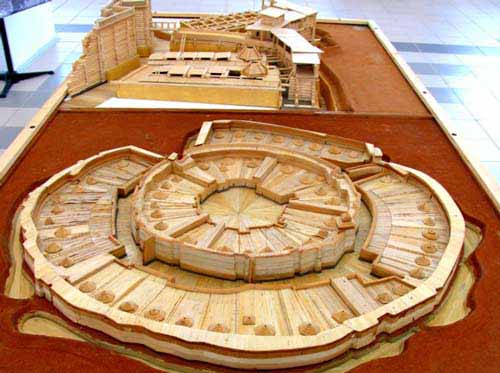
The archeological site Arkaim, in the Russian Chelyabinsk territory, was discovered in the summer of 1987 and declared a national archeological reserve in 1991. In 2005, Vladimir Putin himself visited the site which had become a national treasure. At the time of this writing, over twenty years later, one might assume that the excitement about this discovery and its significance would be waning, but instead, the interest this amazing, ancient site has attracted continues to increase. Why all this excitement?
Many of the three to four thousand visitors to Arkaim every summer witness what some have called a veritable miracle: The remnants of this "Land of Cities" are thought to bear testimony to one of the most ancient civilizations known to man.
Walking among these ruins, people discover original designs, massive walls, complicated defensive structures, furnaces, craft workshops, especially early bronze forgeries and carefully designed infrastructures, as well as many other signs of a culture so ancient that their discovery has definitely disturbed many traditional archeologists. Here, it is believed, the first horses were domesticated and the first two-wheel chariots were built.
There are still scientists who insist upon placing 'man’s origin' within certain rigid time-frames, even though they have long been dis-proven by many archeological discoveries. Nevertheless, for various reasons too complex to mention in this introductory article, these are still not added into our children’s history-books.
After the archaeologists, historians and ethnographers, the psychics arrived, along with prophets, pilgrims and members of various religious sects, all people thirsting for spiritual healing or enlightenment and each wanting to personally see "The Place".
Arkaim has been featured in articles, both scientific and general, movies, presentations at scientific conferences and many carefully researched books and monographs which have since been published.
Many historians and archeologists agree that visitors to this area are viewing the ancestral homes of ancient Aryans, for which many scientists have searched diligently. Covering the vast territory of the Bolshaya Karaganskaya river valley, they believe that this is the place where at the turn of the third to second millennium BC a historical split occurred, namely that of Aryans dividing into two branches, the Indo-Iranian and Iranian, a scientific fact that had already been documented by linguists much earlier.
Even some of the most conservative scientists are prepared to acknowledge that these places were the
native lands of Zarathustra, the author of the sacred hymns of "Avesta", a sage as legendary as the Buddha or Mahomet.Understandably, many individuals who had been searching for the tap-roots of their ancestral origins had difficulties calming their excitement and imagination. After all, this discovery by South Ural archaeologists did represent somewhat of a miracle even to those observers unaffected by such longings. It was one of those discoveries that would force any diligent scientist to reconsider the paradigms they had developed over decades if not centuries.
The implications of the findings as well as the ensuing research were as important to the field of archeology as they were for the - too frequently minimized - 'spirito-philosophical' needs of many of the pilgrims.
Arkaim's age represents a predicament which has forced historians to change their concepts of the Bronze Age on the territories of the Ural-Kazakhstan steppes. It now appears that the latter was not the era which was to define a world about to enter into its first experience of civilization. The discovery and signs of high levels of metallurgical development puts this region into another most significant position culturally, extending, as it does now, from the Mediterranean to present-day Kazakhstan and Central Asia.
Very unique metal objects of amazing workmanship had been found at the coasts of the Aegean sea as well as in the Southern Ural Mountains, attesting to extensive cultural contacts. It now appears that these in fact had “migrated” by caravan - or wandered, as it were - not "from there to here", but "from here to there", namely from Russia to Greece rather than the reverse, as had been assumed.
The importance of such detailed clarifications of historical travel and whether it happened from hither to thither or vice-versa might be brushed aside. But their importance is not lost on people who consider them essential to their regional patriotic ambitions, not a comfortable arena to enter into in modern-day Russia, nor anywhere else in the world. After all, it is still a world bleeding from ideological conflicts based upon misused patriotic identifications.
But discoveries of such importance are extremely rare, occurring maybe once in a century. So we must not be shy nor hide behind the memories of our deepest wounds from the most perverse of perpetrations, nor beneath newly created hysterias. Some of these fears are very understandable. Yet neither our ever-living wounds of World II nor of other ancient or recent regional wars should distract us from this noble goal of finding something so possibly uniting for feuding nations as a common gene-pool to much of humankind.
Many sciences already do point to such a possibility, notably gene-samples from all races. Must such innocent curiosities and claims really continue to be so heavily burdened with memories of political abuses by truly deranged leaders whose names we need not mention here?
But reasonable reactions notwithstanding, why have people who are looking for their roots in the direction of Vedic ancestry been more suspect than any other indigenous people curious about their heritage? After all, it would appear to be an uncommonly large area upon which such ancestors would have enjoyed their apparently advanced culture. Such a culture would seem to have "fed" much of what we now call Western civilization and parts of Asia, including migrated tribes, such as American Indians and even Europeans settling America.
Moreover, as we also explore elsewhere regarding linguistic research efforts around the so-called Nostratic or Proto-Language question, some linguists are struggling with the possibility of linguistic ancestral roots for possibly ALL humankind, of all colors, so that the suspect idea of any "superiority" should be supported as an excitement for all of humanity maybe re-discovering its true origin and common spiritual heritage.
But even if we just return to the simple idea of a very ancient highly evolved Vedic culture, as many scientists such as archeologist Michael Cremo are discovering and support. Again: Why was this essential piece of possible human history and origins so completely "lost" to a searching world for millennia? After all, we had not lost all their ancient remains. (Cremo coined the term Human Devolution and used it as the title of one of his books to describe that hypothesis of our human race having de-volved from a high civilization, rather than evolved from cavemen.)
And why did someone as powerful as Anastasia, the recluse of the Siberian Taiga who many of our readers admire for what seem to be super-human powers and a deep, spiritual integrity, pause and then say out loud and with very conscious caution and deliberation, "I am Ved-Russ", seemingly prepared to inherit a great cosmic rain of wrath upon such a claim? She explained to author Vladimir Megre that she was a member of an unbroken ancestral lineage hailing from the Vedic culture which used to extend from her native boreal forest lands to large parts of Europe.
Cremo has inherited, maybe not cosmic, but establishment wrath and professional ridicule, along with many others who have even lost their University positions because of unusual discoveries and related publications they dared to disseminate. WHY must anything disappear that is not in keeping with the prevailing paradigm of the short-lived human fairy-tale constructed for and bottle-fed to us modern folk? What could be so dangerous about discovering a bit of missing - though admittedly quite fabulous and empowering - human history?
Some people claim that such discoveries as Arkaim do not happen by chance, that Time itself works upon them - as if a critical mass of expectation might bring them to consciousness. (Ed. note: Your editor could not miss the fact that the discovery of this site happened exactly 21 years ago, in the year when many other earth-moving events happened, all in keeping with what people with transpersonal leanings called the Harmonic Convergence. Even our completion day for this special Magazine - perchance - had fallen upon the anniversary date of that event, which was considered a turning-point in the evolution of the planet’s quality of consciousness).
Maybe there are other explanations yet for the strange events leading to the discovery and last-minute preservation of Arkaim - which was slated to be flooded to create a reservoir - only to be found in the eleventh hour by some schoolboys who received a can of condensed milk for their literally ground-breaking discovery. Actually, the ruins had been perfectly visible on aerial photographs taken prior to the year of the ancient city’s discovery.
Experts had been confused, was the speculation offered, by the excellent preservation of the ancient monuments: everybody assumed that these kinds of accurate geometrical forms must have been of purely modern origin. Why was no-one asking about these strange-looking arrangements? In the Russia of the past, a "top-secret" country full of restrictions, it was not encouraged to ask possibly unwelcome questions, and yet, one might assume that the government itself may have wanted to explore these unusual, presumably "modern" arrangements.
The "miracle-rescue" of Arkaim, namely the fact that this precious site had practically been doomed, did not escape the attention of the mass media, who spoke about this aspect as the second miraculous fact about Arkaim, the first being its very existence. With Its location as a construction zone for a huge water reservoir, orders had already been signed on the highest governmental levels.
At the time that archaeologists were called in, blueprints had been confirmed, large investments had been made and construction was already under way. The estimated time frame for job completion was only a few months, if not weeks away, and it seemed there was no power in the world capable of stopping such a heavy flywheel of a planned and very profitable economic investment and local necessity. The retaining dam had been erected and all that was left to do was to fill up a short crosspiece - and the spring floods would have left no trace of Arkaim.
This second miracle, however, was not heaven-made but created by Man. Many people still remember how scientists, journalists and intellectuals took a stand for the Ural’s Troy (a comparison which, it turned out later, actually flattered the ancient Troy, which is considered to be a millennium younger than this hoary site).
The struggle for Arkaim’s rescue was part of a public crusade against the typical arbitrary treatment of the Soviet system of that time, namely a bureaucratic attitude with focus on utilitarian rather than cultural values. It did indeed help the cause that this system was nearly dead and that Ural's branch of the Academy of Sciences (AS) Arkaim archeological site and a section of reconstructed wall. Ancien logs are sticking up from the ground. threatened to resign from the Academy if Arkaim was not protected.
Below are excerpts from letters received by the editorial office of the newspaper 'The Science of Ural' which, at that time, was used as headquarters for the rescue campaign: "For how much longer will bureaucrats decide what is needed for the people and what is not? The Ministry of Water Industry does not need Arkaim. But we do!" And: "If Arkaim is not rescued, the idea of socialism for me will fall once and for all."
The idea of socialism did fall indeed, but Arkaim remained.
What do scientists say about Arkaim? The man who has the honor of being the pioneer in the discovery of this ancient site, archaeologist Gennady Borisovich Zdanovich, explains: I see Arkaim as the brightest example of an integration of primitiveness, unity and wholeness which combines very different functions.
It is at once a fortress, a temple, a craft centre, and an inhabited settlement”. Astro-archeologist K. K. Bystrushkin adds another important note: In addition, Arkaim is also a celestial observatory of extreme accuracy, the most complex of those presently known to mankind. In this respect it is compared to Stonehenge, the well-known megalithic structure standing on the Salisbury plain in Southern England. As early as the middle of the eighteenth century, it was believed to represent the most ancient observatory in the world.
This hypothesis was confirmed and received wide recognition two hundred years later. However, Arkaim appears to be an observatory of much more sophistication than Stonehenge. Another important fact is its age: archeologists estimate that the age of Arkaim is close to 3800 - 3600 years. K. K. Bystrushkin, according to his methodology, increases this age by one thousand years. What do we do with evidence and a heritage of such a highly evolved culture - with an age of ~ 4800 years?